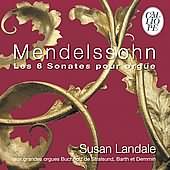For her recording of Mendelssohn’s six organ sonatas, Susan Landale uses three restored 19th-century Bucholz instruments. I suspect that their richly sonorous yet individual timbres provide at least some of the impetus behind Landale’s mostly passionate and flexible interpretations. In the First sonata, Landale builds the animato section well, and effects subtle registration contrasts between manuals in the Adagio, although her clunky, foursquare handling of the Finale barely suggests the Allegro assai vivace that Mendelssohn requests. Conversely, blurred textures result from Landale’s hectic pace for the Allegro maestoso e vivace section that introduces No. 2’s closing fugue.
No. 3’s Andante tranquillo features lovely, transparent woodwind stops that suit the music’s underlying tenderness better than the brighter registrations heard in William Whitehead’s contemporaneous Chandos recording. Similar observations pertain to Landale’s lyrical, softer-grained shaping of No. 5’s last movement when juxtaposed with Whitehead’s more massive conception. My principal beef concerns Calliope’s drab engineering, where loud, dense passages generally sound muddy and congested in comparison to the closer, clearer sonics that Chandos offers, or, better still, Hans Fagius’ version on BIS.
































